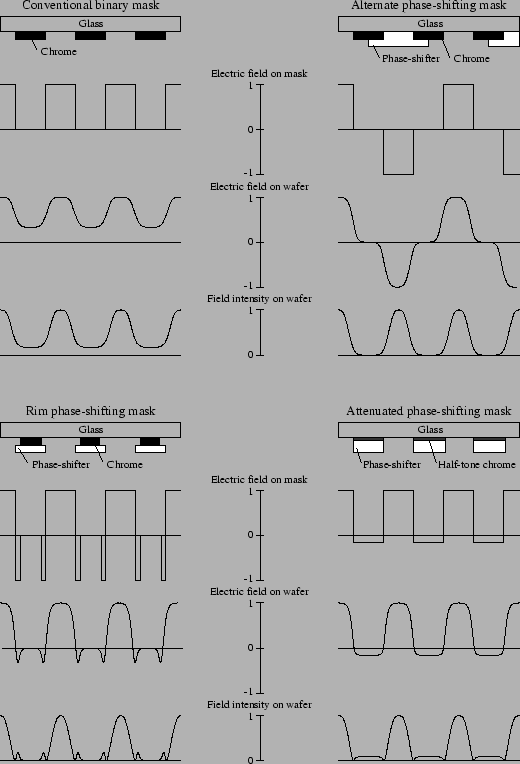



Next: 2.5 Optical System
Up: 2.4 Photomask
Previous: 2.4.1 Binary Masks
2.4.2 Phase-Shifting Masks
Adding a phase-shifting function to the on-off property of
binary masks yields a higher resolution at the same or even larger amount
of depth of focus. Thus phase-shifting, like off-axis illumination,
is a technique to reduce the k1 parameter in (2.1).
The enhancement stems from the fact that both amplitude and phase
are used to store the information about the image on the mask.
The phase-shifting principle was already introduced in 1982 by
Marc Levenson [16], but has long remained a development tool.
Recently enormous efforts for industrial application have been made,
and pilot production has already started.
The operation principle and the most important types of phase-shifting masks
are shown in Figure 2.6. A detailed overview on
phase-shifting masks including pros and cons of various approaches,
the fabrication process as well as repair and inspection issues can be
found in [17].
Figure 2.6:
The most
relevant types of phase-shifting masks (PSMs) and their operation
principle in comparison to a conventional binary mask. The alternate or
Levinson PSM offers considerable enhancement in image contrast and depth of focus
but is limited to closely packed patterns to be efficient.
The rim PSM approach can be applied to arbitrary mask layouts and is most
effective for line and hole openings. Drawbacks are exaggerated proximity
effects, the increase in space due to the rim shifter,
and the extreme sensitivity on the size
of the rim shifter. Similar to rim PSMs, attenuated PSMs are most effective for
line and hole
openings, apply to arbitrary patterns, can be self-aligned, have
proximity effects, and need larger openings than the desired images.
However, the attenuated PSMs are better than rim PSMs in all aspects.
|
|




Next: 2.5 Optical System
Up: 2.4 Photomask
Previous: 2.4.1 Binary Masks
Heinrich Kirchauer, Institute for Microelectronics, TU Vienna
1998-04-17

